#uncle tom's cabin
Text
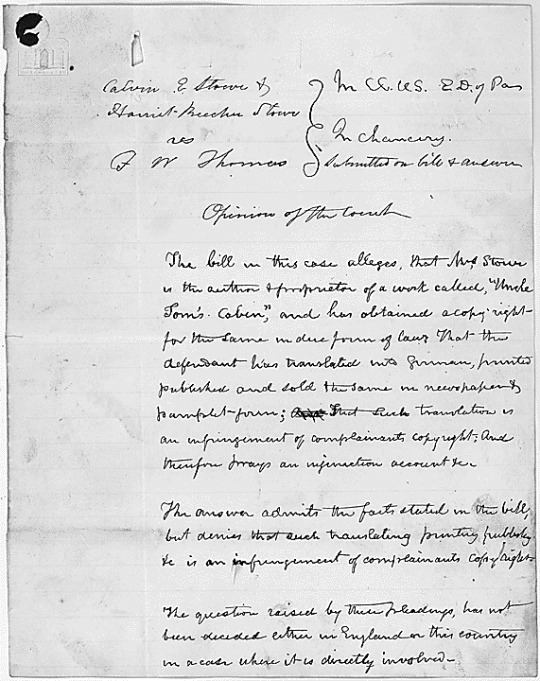
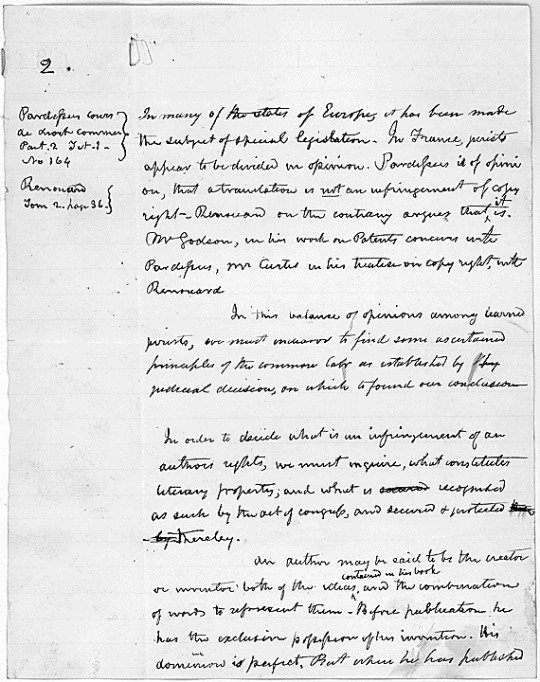
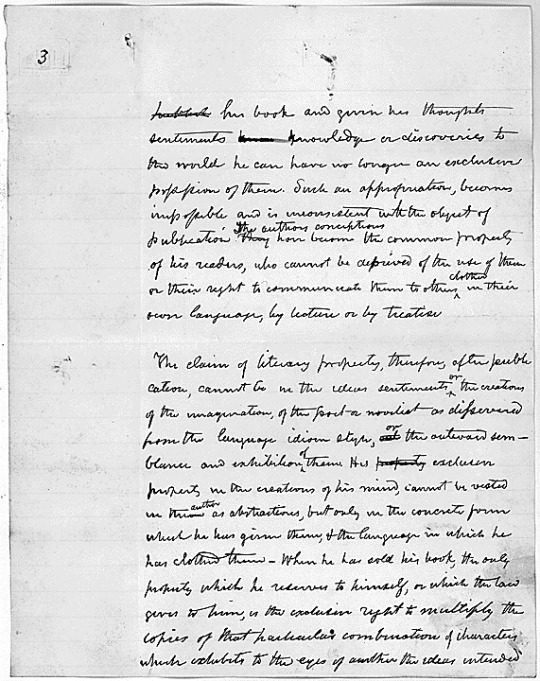
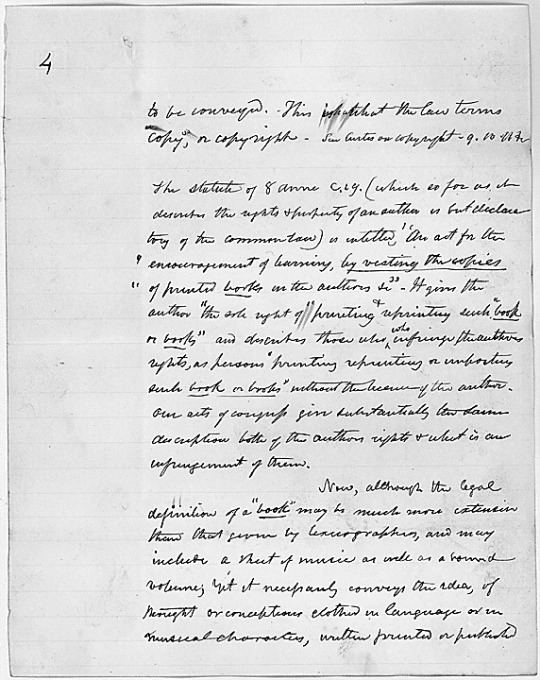
Opinion of the Court in Stowe v. Thomas
Record Group 21: Records of District Courts of the United StatesSeries: Equity Case FilesFile Unit: Stowe v. Thomas, Case #9 October Session 1852
Calvin E Stowe & [bracket] In CC. US. E.D. of Penn Harriet Beecher-Stowe vs In chancery F W Thomas [end bracket] Submitted on bill & answer Opinion of the Court The bill in this case alleges that Mrs Stowe is the author & proprietor of a work called, "Uncle Tom's Cabin," and has obtained a copyright for the same in due form of law; that the defendant has translated into German, printed published and sold the same in newspaper & pamphlet form; [struck through] That such translation is an infringement of complainants copyright; And therefore prays an injunction account &c. The answer admits the facts stated in the bill, but denies that such translating printing publishing &c is an infringement of complainants copyright. The question raised by these pleadings, has not been decided either in England or this country in a case where it is directly involved2. Pardessus cours [bracket] In many of the states of Europe, it has been made the de droit commer subject of special legislation. In France, jurists appear Part. 2 [T?]. 1 to be divided in opinion. Pardessus is of opinion, that No 164 [end bracket] a translation is not an infringement of copyright, Renouard on the contrary argues that ^it^ is. Mr. Godson, in his work Renouard [bracket] on Patents concurs unto Pardessus, Mr Curtis in his Tom 2. Page 36. [end bracket] treatise on copyright unto Renouard In this balance of opinions among learned jurists, we must endeavor to find some ascertained principles of the common law as established by [struck through] judicial decision, on which to found our conclusion In order to decide what is an infringement of an authors rights, we must inquire, what constitutes literary property; and what is [struck through] recognized as such by the act of congress, and secured & protected [struck through] thereby. An author may be said to be the creator or inventor both of the ideas ^contained in his book^ and the combination of words to represent them. Before publication he has the exclusive possession of his invention. His dominion is perfect. [full transcription at link]
#archivesgov#December 24#1853#19th#harriet beecher stowe#stowe v. thomas#copyright#uncle tom's cabin
26 notes
·
View notes
Text
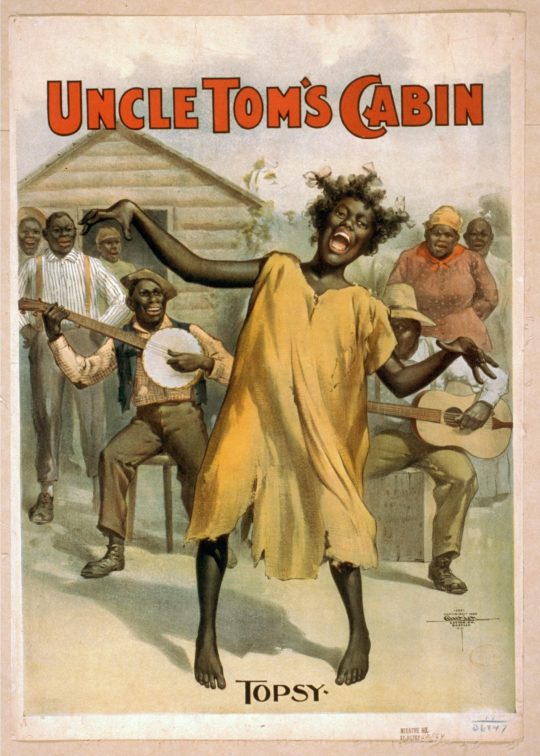

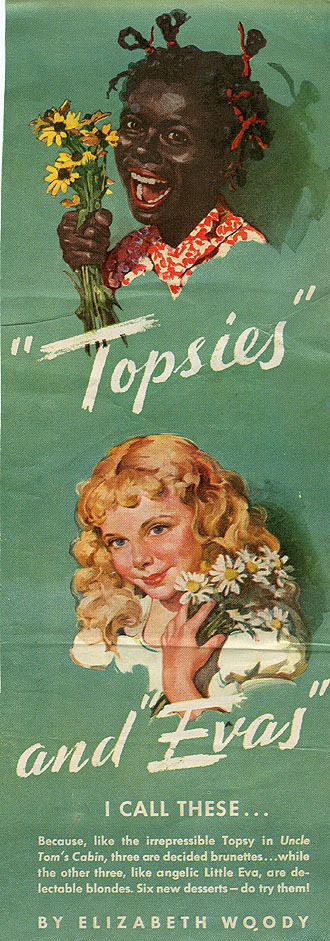

“Nothing is scarier than real American history – minstrel shows and Uncle Tom’s Cabin.” - Misha Green ; Lovecraft Country Showrunner

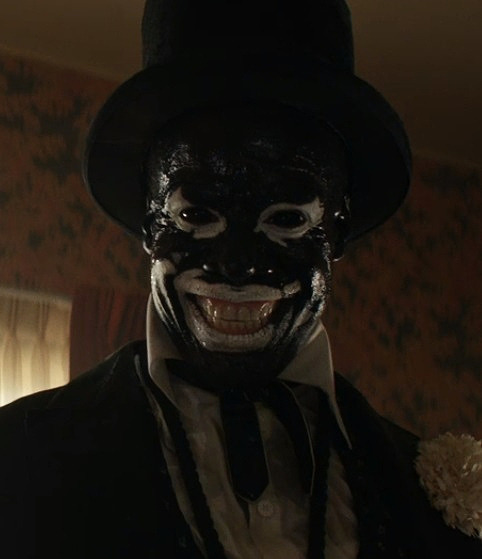

"There is a history of white folks donning some abomination of blackness" - Little Marvin ; Them Creator & Executive Producer
#lovecraft country#them#da tap dance man#topsy x bopsy#blackface#minstrelsy#uncle tom's cabin#history#horror#series#american history#2020s series#quotes#misha green#little marvin#racist caricatures#pickaninny#racism as horror fuel is the greatest idea
57 notes
·
View notes
Photo
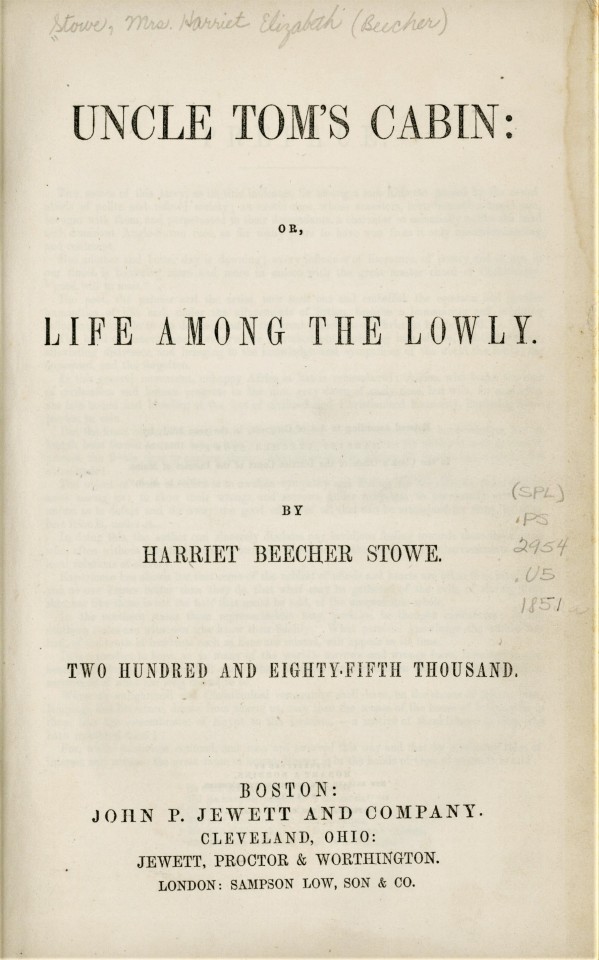

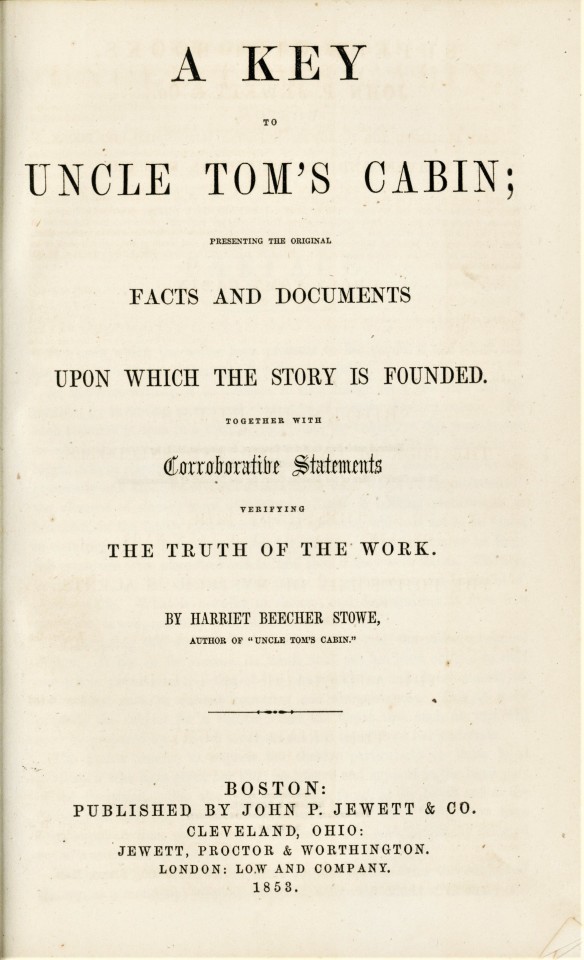
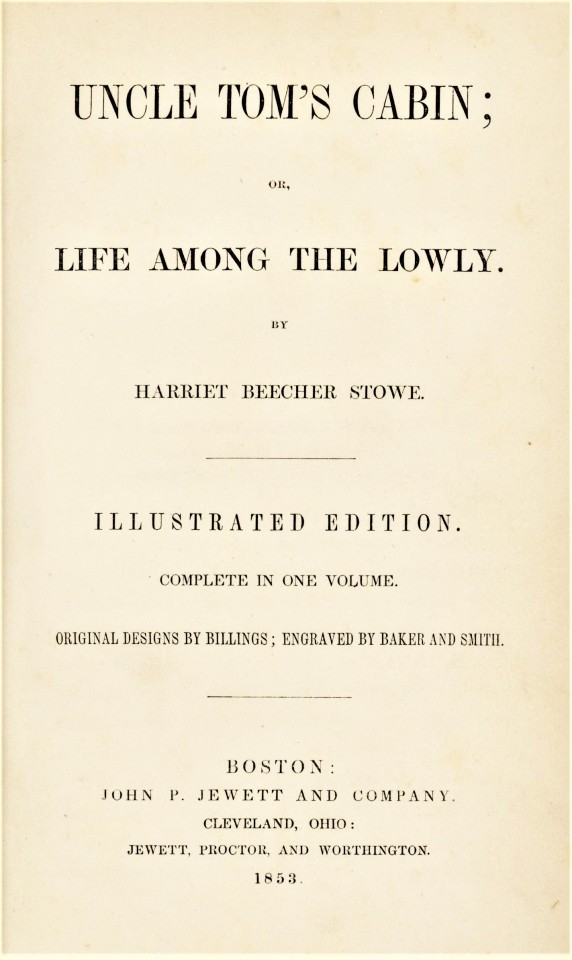



Milestone Monday
On this day, May 20 in 1852, Harriet Beecher Stowe's Uncle Tom's Cabin was published in Boston by John P. Jewett. Its popularity was so great that the first edition went through many printings and sold 300,000 by the end of the year in the U.S. alone (1.5 million were sold in Britain in the first year). Jewett had presses in operation 24 hours a day to keep up with demand.
Our copy is one of the later printings for that year, the 285th thousand, and was published in one volume without the six full-page illustrations by Hammatt Billings engraved for the first printing. In late 1851, Jewett, along with partners Proctor and Worthington, formed a second publishing business in Cleveland, which took on the responsibility of selling Uncle Tom's Cabin in the west, which is reflected on the title page of our printing. Our particular printing was also issued later and bound with the 1853 A Key to Uncle Tom's Cabin.
We also hold the first illustrated edition of Uncle Tom’s Cabin, published by Jewett in 1853 with many illustrations by Billings engraved by Baker and Smith, and we show some of those illustrations here as well.
View more Milestone Monday posts.
#Milestone Monday#milestones#Harriet Beecher Stowe#Uncle Tom's Cabin#John P. Jewett#Hammatt Billings#A Key to Uncle Tom's Cabin#illustrated edition#Baker and Smith#publishing history
35 notes
·
View notes
Text
I wish I could remember where I once read the suggestion that Hugo’s characterization of Jean Valjean might have been influenced by Harriet Beecher Stowe’s characterization of Uncle Tom.
It’s been a long time since I read Uncle Tom’s Cabin, but from what I remember of it, and if Hugo really did read it, then I wouldn’t be surprised if that claim was true. I wish Stowe’s book hadn’t been hijacked by racist stage adaptations that gave the phrase “Uncle Tom” its current meaning. Then the character of Tom could be remembered as the Jean Valjean-like figure she meant him to be: a quietly strong, pious man who lives a life full of hardship and social injustice, but who resists the temptations of bitterness and hate, and instead constantly helps, protects, and sacrifices for others.
(I’m not saying there’s nothing problematic about Tom – he was written by a white woman pre-Civil War, and he probably is more of a Christlike paragon than a three-dimensional human being – but he’s not a subservient stereotype!)
At any rate, if that suggestion is true, then all the more reason for a modern Les Mis adaptation to cast a black man in the role of Valjean!
21 notes
·
View notes
Photo

Uncle Tom's cabin, or Slave Life in America by Harriet Beecher Stowe, 1853.
31 notes
·
View notes
Text

As the temperatures drop and night falls earlier each evening, staying inside to read is a constant temptation! What work of #classicliterature featuring snowy nights or icy storms are you eying on your TBR this month?
#classic literature#literature#winter reads#winter reading#Frankenstein#Ethan Frome#Anton Chekhov#Anna Karenina#Uncle Tom's Cabin#In Our Time#currently reading#TBR#december TBR#book#books#booklr#studyblr#norton critical editions#norton editions
16 notes
·
View notes
Photo

Robert S. Duncanson, Uncle Tom and Little Eva - Wikimedia
9 notes
·
View notes
Text
I'm glad I read Uncle Tom's Cabin before I read Little Women.
Most of Louisa May Alcott's generation would have, of course – or even if they hadn't read the novel of Uncle Tom's Cabin, they would have seen one of the countless popular stage plays of it. But today, of course, most people read Little Women first, or Little Women only. So most modern readers tend to see Beth as just a simple, straightforward example (whether touching or nauseating) of an angelic, doomed young girl, too pure for this world, like so many others in 19th century fiction.
Personally, I'm glad I met little Eva before I met Beth. Seeing how super-angelic, pure, and sparkling a figure Eva is, and reading the melodramatic religious glory of her deathbed scene, made me appreciate Alcott's effort to make Beth more human. Unlike Eva, Beth isn't described as being physically beautiful; she also has slight flaws amid her sweetness, and has growth of her own (e.g. overcoming her fear of old Mr. Laurence and befriending him) rather than only existing to teach goodness to others by her saintly example; she doesn't supernaturally foretell her own death or have visions of heaven; she struggles with her physical pain and with depression during her final illness; Alcott's narrative voice is affectionate toward her, but doesn't glorify her as a literal angel on earth; and her eventual death scene is short, quiet, and understated, not an operatic spectacle. Alcott didn't subvert the popular archetype of the saintly dying girl, but she did handle it more realistically (helped, of course, by the fact that she modeled Beth after her very real sister). The sentence that precedes Beth's death, "Seldom except in books do the dying utter memorable words, see visions, or depart with beatified countenances..." feels like a specific reference to Eva's then-iconic death, with her departing vision of "love – joy – peace!"
It's too bad that for most readers, Beth is the first example of the "saintly dying 19th century girl" archetype they meet, so too many view her as just a cardboard example of that archetype, instead of the more humanized version she really is compared to earlier examples in other books.
@littlewomenchannel, @thatscarletflycatcher, @joandfriedrich
#little women#beth march#louisa may alcott#uncle tom's cabin#eva st. clare#harriet beecher stowe#tw: death
21 notes
·
View notes
Photo



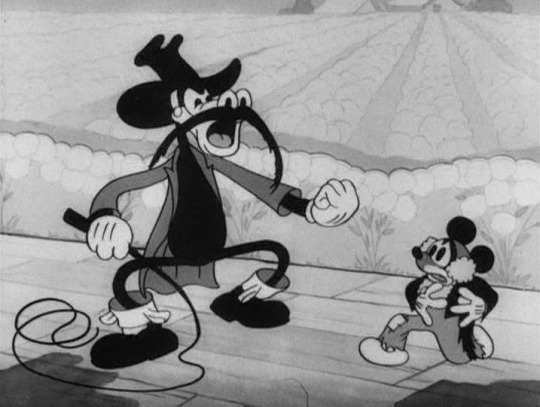



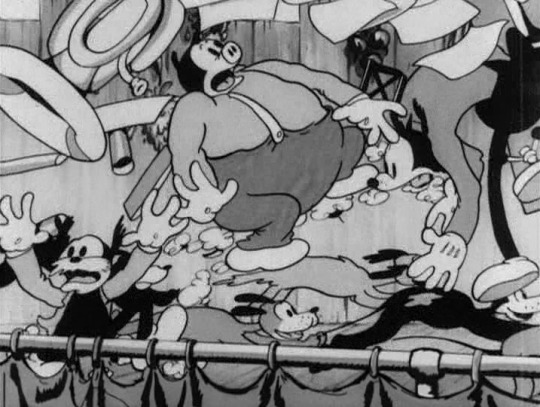
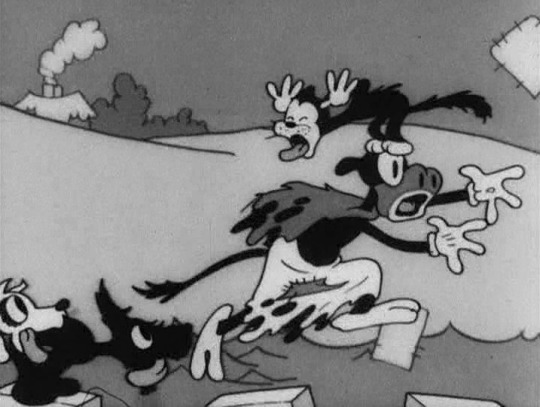
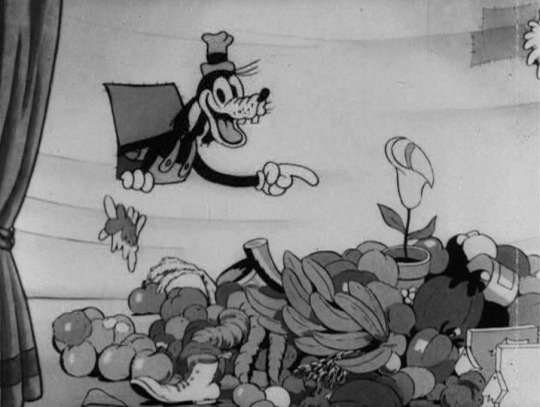
Mickey’s Mellerdrammer (1933, Wilfred Jackson)
Mickey Mouse #54
4/10/23
#Mickey's Mellerdrammer#Mickey Mouse#Goofy#Minnie Mouse#Clarabelle Cow#Disney#cartoon#animation#30s#Walt Disney#Wilfred Jackson#Pinto Colvig#theater#Uncle Tom's Cabin#blackface#dogs#cats#melodrama
4 notes
·
View notes
Text
TB is thought to be relatively painless. Cancer is thought to be, invariably, excruciatingly painful. TB is thought to provide an easy death, while cancer is the spectacularly awful one. For over a hundred years TB remained the preferred, edifying way of killing off a character in a novel or play—a spiritualizing, refined disease. Nineteenth-century literature is stocked with descriptions of painless, unfrightened, beatific deaths from TB, particularly of young people: of Little Eva in Uncle Tom’s Cabin and of Dombey’s son Paul in Dombey and Son and of Smike in Nicholas Nickleby, where Dickens describes TB as the “dread disease” which “refines” death
of its grosser aspect…in which the struggle between soul and body is so gradual, quiet, and solemn, and the result so sure, that day by day, and grain by grain, the mortal part wastes and withers away, so that the spirit grows light and sanguine with its lightening load….
Contrast these sentimental, ennobling TB deaths with the slow, agonizing cancer deaths of Eugene Gant’s father in Thomas Wolfe’s Of Time and the River and of the sister in Bergman’s film Cries and Whispers. The dying tubercular is pictured as made more beautiful and more soulful; the person dying of cancer is portrayed as robbed of all capacities of self-transcendence, humiliated by fear and agony.
— Illness as Metaphor (Susan Sontag)
#susan sontag#illness as metaphor#history#medicine#biology#human biology#literature#film#movies#religion#christianity#feminism#misogyny#harriet beecher stowe#charles dickens#thomas wolfe#ingmar bergman#uncle tom's cabin#dombey and son#nicholas nickleby#of time and the river#cries and whispers#cancer#tuberculosis
3 notes
·
View notes
Text
(I know it's actually 19th century didactic literature that includes both Christian and sociological didacticism, for the record, but this poll isn't about that)
0 notes
Text
0 notes
Text
0 notes
Text
The swinging santa

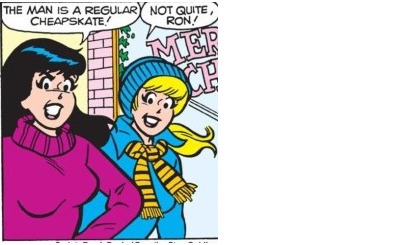
I had to look up "Simon Legree". The bad guy in Uncle Tom's Cabin. Funny thing, the second published Archie story and second of two with a 1941 cover date concerns a school stage production of Uncle Tom's Cabin. Not a likely occurrence anymore, and it is notable that in the couple of "one story from each year" collections that Archie sticks with the first one. The book which has fallen out of favour for any literary value -- stock characters and melodrama abound -- but for historical interest probably demands a slog through. I think the general thought on Uncle Tom himself is he holds up above the pejorative he inspired in the book, but the name earns its reputation in subsequent popular stage productions. Would Veronica be apt pull the name of a character out from the book in 1979? I don't know.
He has been replaced by a "Mr. Spacely". At first I am thinking -- Kevin Spacey? That makes a weird choice -- but maybe there is An Unusual Suspects fan on staff. Funny, though, it would require a subsequent re-editing in light of sexual misconduct and court cases. Which they indeed do to the generic and unspecified. Though this change only makes Betty's "not quite" off now.
But upon review, the citation of Mr. Spacely is referring to the stingy boss in The Jetsons. Probably a good analogue for Charles Dicken's Scrooge mentioned in the next panel, or at least better than Harriet Beecher Stowe's violent slave owner character. But why is a Jetsons character on Veronica's mind? Why, from reading the Jetsons comic book that was licensed to and published by Archie Comics! Except if that is the case it would have had to be a holdover from an issue published in 1995 that is not indexed at comics for org.
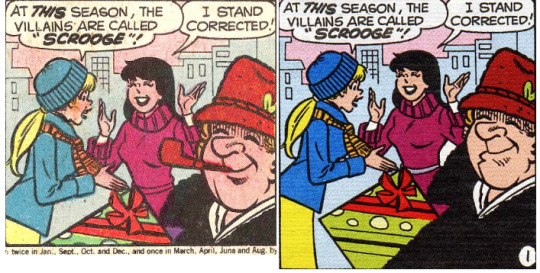
And goodbye to pipes. And the wrapped present we had assumed the man was carrying is now shown to just be floating along.
#Archie Comics#Betty Cooper#Veronica Lodge#Christmas#Uncle Tom's Cabin#A Christmas Carol#The Jetsons#Pipe#Indicia filler#Stan Goldberg#1979#Fired Santa
1 note
·
View note
Text
Have I shared this before? Because I freaking love this song.
0 notes
Text
The hugely successful anti-slavery tale by US writer Stowe (1811-96) helped to persuade readers that Christian beliefs and slavery were incompatible.
on Uncle Tom's Cabin (1852), Harriet Beecher Stowe
taken from The Literature Book: Big Ideas Simply Explained, by James Canton (x)
☕ would you like to buy me a cup of coffee? (x)
#juli-quotes#juli-the-literature-book#uncle tom's cabin#harriet beecher stowe#slavery#anti-slavery#english literature#american literature#academia#literature student#literature studyblr#light academia#dark academia#english lit#classism#oppression
1 note
·
View note